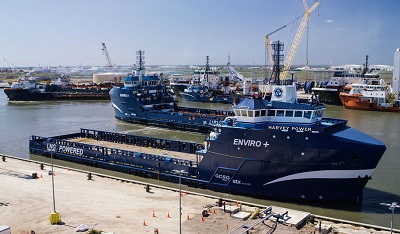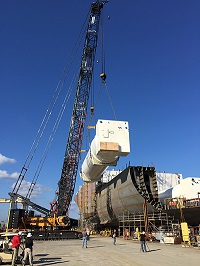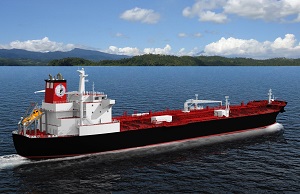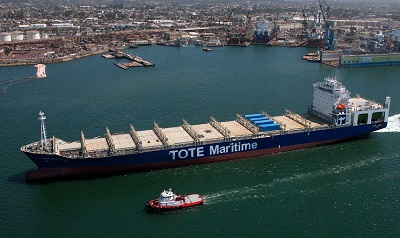The Week in Review: The LNG-As-Fuel Revolution
Despite challenging market conditions, significant steps are being taken to boost the number of LNG-fuelled vessels in the merchant and offshore fleets of the world. The U.S. fleet has seen a growing number of LNG-fuelled and LNG-ready vessel developments, and this last week marked some important milestones (below).
Driving the Revolution
The move to LNG-fuelled vessels has been termed a revolution for the shipping industry, but lower crude prices have impacted the cost benefits analysis for shipowners considering the adoption of LNG as a marine fuel.
However, the environmental and regulatory drivers remain. Burning LNG can reduce up to 95 percent SOx, nearly 100 percent particulate matter, 90 percent of NOx and up to 25 percent CO2. It also allows ships to meet MARPOL Annex VI requirements (Reg13 NOx + Reg14 SOx), the E.U. Sulphur Directive requirements (Directive 2012/33/EU) and promotes the implementation of the Alternative Fuels Infrastructure Directive (Directive 2014/94/EU).
Lessons Learned by Early Adopters
In its latest edition of Bunkering of Liquefied Natural Gas-fueled Marine Vessels in North America, classification society ABS highlights key lessons learned from early adopters about making the switch to LNG as a fuel:
• The adoption of LNG as a marine fuel requires a dedicated team.
• Use trusted advisors and partners to leverage the limited industry experience in gas-fueled vessels.
• LNG is readily available for marine bunkering, however, transport and bunkering contracts can be challenging.
• Proper crew training is essential to promote the safe use of LNG as a marine fuel.
• Early and often dialogue with regulators is essential.
The OSV Harvey Power
The Harvey Power, the second LNG-fuelled OSV operating in the United States, entered service last week. The vessel is working for Shell Upstream America’s deep water operations in the Gulf of Mexico.
 Harvey Power is the second of six LNG OSVs being built for Harvey Gulf International Marine by Gulf Coast Shipyard Group, and like its sister ship, Harvey Energy, Harvey Power is capable of operating on LNG or diesel fuel.
Harvey Power is the second of six LNG OSVs being built for Harvey Gulf International Marine by Gulf Coast Shipyard Group, and like its sister ship, Harvey Energy, Harvey Power is capable of operating on LNG or diesel fuel.
Along with being able to operate on LNG, it also meets the criteria of the ABS Enviro+ Green Passport notation. When operating on LNG, these vessels exceed the new Tier IV emissions regulations requiring lower sulfur oxides and nitrogen oxides emissions as part of the North American Emission Control Area.
The vessel will refuel with LNG at Harvey Gulf’s new LNG bunkering facility at Port Fourchon in southern Louisiana. When operating on LNG, the Harvey Power can operate in excess of 19 days in normal Gulf of Mexico rig supply mode between refueling.
Crowley’s Conro
 Last week, Crowley Maritime announced that construction of the first of two LNG-powered, combination container (ConRo) ships reached an important milestone with the installation of three LNG fuel tanks. The double-walled, stainless steel tanks – which are 110 feet in length and 20.6 feet in diameter – weigh 225 tons and will hold more than enough LNG fuel for two round-trip voyages between the vessel’s future ports of call, Jacksonville, Florida, and San Juan, Puerto Rico.
Last week, Crowley Maritime announced that construction of the first of two LNG-powered, combination container (ConRo) ships reached an important milestone with the installation of three LNG fuel tanks. The double-walled, stainless steel tanks – which are 110 feet in length and 20.6 feet in diameter – weigh 225 tons and will hold more than enough LNG fuel for two round-trip voyages between the vessel’s future ports of call, Jacksonville, Florida, and San Juan, Puerto Rico.
The two Jones Act vessels, which will be named El Coquí (ko-kee) and Taíno (tahy-noh), are currently under construction at VT Halter Marine.
APT’s ECO Tanker
General Dynamics NASSCO has christened its first 610-foot-long ECO tanker for American Petroleum Tankers (APT). The ECO tanker, the Lone Star State, is the first of a five-tanker contract between NASSCO and APT, which calls for the design and construction of five 50,000 deadweight ton, LNG-conversion-ready product carriers with a 330,000 barrel cargo capacity.
 The construction of the fifth tanker in the series is now underway.The tankers were designed by DSEC, a subsidiary of Daewoo Shipbuilding & Marine Engineering (DSME) of South Korea. DSEC’s ECO design achieves improved fuel efficiency through several features, including a G-series MAN ME slow-speed main engine and an optimized hull form. The tankers will have conversion-capable, dual-fuel-capable auxiliary engines and the ability to accommodate the future installation of an LNG fuel-gas system and tanks.
The construction of the fifth tanker in the series is now underway.The tankers were designed by DSEC, a subsidiary of Daewoo Shipbuilding & Marine Engineering (DSME) of South Korea. DSEC’s ECO design achieves improved fuel efficiency through several features, including a G-series MAN ME slow-speed main engine and an optimized hull form. The tankers will have conversion-capable, dual-fuel-capable auxiliary engines and the ability to accommodate the future installation of an LNG fuel-gas system and tanks.
TOTE’s Container Ship
 General Dynamics NASSCO delivered the world’s first LNG powered container ship, the Isla Bella, to TOTE Maritime this month. As part of a two-ship contract signed in December 2012 with TOTE, the 764-foot long Marlin Class container ships will be the largest dry cargo ships powered by LNG.
General Dynamics NASSCO delivered the world’s first LNG powered container ship, the Isla Bella, to TOTE Maritime this month. As part of a two-ship contract signed in December 2012 with TOTE, the 764-foot long Marlin Class container ships will be the largest dry cargo ships powered by LNG.
TOTE launched the second LNG powered container ship on August 29 at General Dynamics NASSCO in San Diego.
LNG-Powered Bulk Carrier Design
Deltamarin, Arista Shipping, ABS and GTT have announced Project Forward, a joint development project to equip the dry bulk carriers of the future with LNG propulsion. The aim of the project is to develop a commercially feasible LNG-powered dry bulk carrier design capable of complying with the IMO’s Energy Efficiency Design Index 2025 standards, NOx Tier III and Marpol Annex VI SOx emission levels.
The concept design will be based on the highly-optimized Deltamarin B.Delta design suitable for ships between 82,000 and 210,000dwt. It will employ GTT’s membrane-type LNG tanks for fuel containment.
Equally important, the project will also address the existing dry bulk fleet by developing a modularized LNG fuel retrofit solution for bulk carriers of various sizes. ABS will conduct concept and detail design approvals according to its rules for bulk carriers and gas-powered ships.
Project Forward will include a number of stages, with a first time horizon of two years’ applied research and development work. Initial research indicates that the expected emission reductions from Project Forward could be 40 percent for CO2, 80 percent for NOx and 98 percent for SOx.
